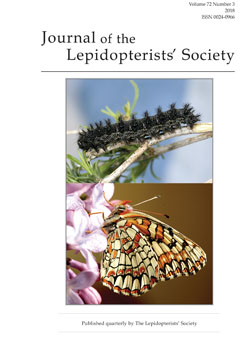Post-diapause third instar larvae of Chlosyne acastus sterope from shrub-steppe habitat near Benton City in central Washington were reared to adulthood at 25 ºC on Chrysothamnus viscidiflorus, Erigeron linearis and a hitherto unrecorded host, Ericameria nauseosa. Larvae developed successfully on all host plants but survival was highest on C. viscidiflorus and E. linearis and lowest on E. nauseosa. Mean larval duration from post-diapause entry into laboratory conditions until pupation was shortest when fed C. viscidiflorus and longest on E. nauseosa or E. linearis. Mean pupal duration was longest on E. linearis and shortest on E. nauseosa and C. viscidiflorus. Mean forewing lengths of adults were shorter when larvae were reared on E. linearis. Ericameria nauseosa is sub-optimal for C. a. sterope in terms of larval survival but produces optimally-sized pupae and adults. Feeding on E. linearis is optimal for survival but slow-developing larvae produce small pupae and adults. Possible fitness implications of this host plant-mediated variation in larval survival, pupal weight, duration and adult size in C. a. sterope are discussed.
How to translate text using browser tools
1 August 2018
Development and Survival of Chlosyne acastus sterope (Lepidoptera: Nymphalidae) Larvae on Three Host Plants in South Central Washington
David G. James,
Lorraine Seymour
ACCESS THE FULL ARTICLE
It is not available for individual sale.
This article is only available to subscribers.
It is not available for individual sale.
It is not available for individual sale.
Desert Yellow Fleabane
fitness
forewing length
Gray Rabbitbrush
Green Rabbitbrush
post-diapause
pupal weight





